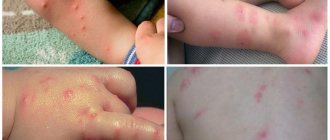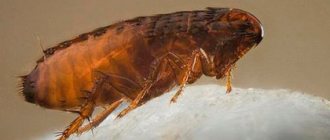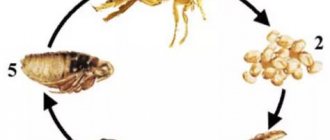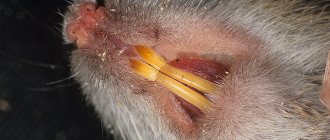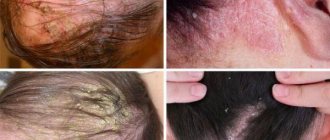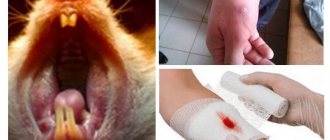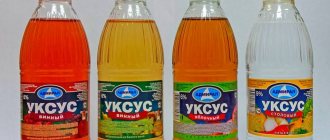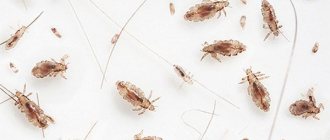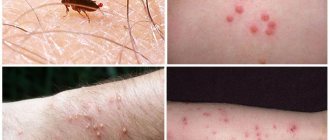Fleas are insects that parasitize warm-blooded animals, including those that can attack humans. Although fleas prefer to parasitize animals and readily bite people, children suffer the most from bites. If a flea bite is treated, the symptoms will not be so pronounced and complications will be minimal. How to treat flea bites in children, what ointments to use or traditional methods of treatment.
What infections can fleas carry?
Parasites feed on the blood of healthy, sick and even dead people and animals. When a flea bites a person, the viruses enter the skin and are carried throughout the body through the blood.
The most dangerous diseases that bloodsucking animals can carry:
- anthrax;
- salmonellosis;
- encephalitis;
- typhus;
- tapeworms;
- fungal infections;
- listeriosis;
- tularemia;
- plague.
The greatest danger is posed by fleas that live on rats. These rodents feed on spoiled foods and dead animals and carry dangerous diseases.
If rats appear in the basement of the house, you need to destroy the rodents and carry out a complete treatment of the room. Companies specializing in disinsection and deratization can best cope with this task.
Types of fleas that live near our children
There are a huge number of species of fleas, more than 2000, and all of them can bite humans. They are essentially omnivorous and can easily change hosts.
Flea on the human body
Let's look at the most common species living in urban areas:
- Dog flea. It occurs quite often, for the reason that dogs are constantly on the street and are the main carrier of these parasites. They are much larger than other pets, and accordingly they can accommodate more inhabitants.
- Cat flea. Second record holder for the number of bites. A cat lives in almost every 3 families, and if in a private house a dog lives on the street, then this domestic animal has full access to a person’s home.
- Rat fleas. It is rare in the city, as is the carrier itself - the rat. However, they are the most dangerous, and if a child is bitten by fleas of this particular species, it is important to make sure that the infection is not transmitted along with the bite.
- Rabbit fleas. The threat of being bitten by this species increases for those who keep rabbits at home, including decorative ones.
- Earth and sand fleas. They live in the homes of rodents and birds (burrows, nests). They are dangerous because, making their way under the nail plate, they lay their eggs there.
- Human flea. This type of parasite does not live on the human body, preferring to settle somewhere in the house. Their mouthparts are better suited than others for piercing human skin, but they do not disdain animals.
Signs of flea bites
Flea bites on a child's head
In adults, flea bites are less pronounced than in children. The child becomes restless and irritable, the affected area becomes very dense, and a blister with a red halo appears. Severe itching appears almost immediately. Insects easily bite through the delicate skin of children, so bite marks can be found on any part of the body, including on the scalp. The legs, arms and face are most often affected.
You can distinguish flea bites from damage caused by other insects by the following signs:
- Flea bites in children are located chaotically, 2–3 pieces each. Single bites practically never occur.
- There are no anesthetic components in flea saliva. At the moment of the bite, the child experiences pain comparable to discomfort from an injection.
The immune system develops up to 14–16 years of age, so even one flea bite can cause an allergic reaction (rash, itching, swelling). It is important to ensure that the child does not scratch the injury site, as this increases the risk of infection.
First aid
Tavegil
If your child is bitten by fleas, wash the wound with cold water and antibacterial soap. If you are allergic to bites, you should use any antihistamine. Suitable for treating children:
- Diprazine.
- Fenistil.
- Diazolin.
- Suprastin.
- Tavegil.
Before giving medicine to a child, you need to read the instructions, which indicate at what age the drug can be taken.
Flea bites can be lubricated with the following products:
- ethyl alcohol or vodka;
- baking soda solution;
- Sulfuric ointment;
- calamine solution.
If a child scratches the skin, the wounds should be treated with brilliant green or iodine. If desired, you can use pharmaceutical ointments (Nezulin, Bepanten or Psilo-balm). To prevent further scratching, the treated areas are bandaged.
If the itching does not subside, the affected areas of the body can be immersed in very cold water. If the bites are located in hard-to-reach places, apply ice or frozen meat. If necessary, make a compress of 1 tsp. baking soda and 1 glass of water (helps relieve itching).
Flea bites in a child after sleeping on the back or legs
Often the bites of some blood-sucking insects are confused with others. Getting to the truth is very important because you need to decide on methods of struggle. If done incorrectly, parasite attacks will continue.
If after sleep a child develops bites on his legs or back, it may not only be fleas. The latter, most often, bite in the evening, when the child is walking, crawling on the floor, or sitting motionless on an armchair, high chair, or sofa. Fleas do not sneak under the blanket or crawl under clothes.
Inflamed marks after sleep on the back and legs are signs of a room infestation with bed bugs. Blood-sucking parasites hide during the day in hard-to-reach places, away from sunlight, and crawl out to eat at night. During the bite, an anesthetic substance is injected, so their attack is invisible to a sleeping person. During one meal, an adult drinks about 11 ml of blood and bites several times. The bites are placed side by side, forming a specific path. Outwardly, it looks more like a mosquito bite. The inflamed spot is very itchy and takes a long time to heal. Young children often develop additional rashes on their bodies.
Folk remedies
The following remedies will relieve pain:
- Vinegar. Mix the apple product with water in equal proportions. Treat the bite areas with a ready-made product (for convenience, you can use a cotton swab). Vinegar will soothe irritated skin, relieve itching and redness.
- Aloe. Cut a plant leaf lengthwise and apply the inside to the affected areas of the body. Secure with adhesive tape or bandage.
- Decoction of medicinal herbs. Mix plantain, coltsfoot, calendula, chamomile and green tea in equal proportions. Place 2-3 tbsp in a saucepan. l. collection, pour boiling water over low heat. After 15 minutes, remove the pan from the stove and strain the liquid. Wipe the skin with the prepared decoction several times a day.
- Baking soda. Pour 1 tsp. baking soda with a glass of warm water, stir. Use the resulting solution to wipe the skin, lotions or compresses.
If there are a large number of bites, the skin should be treated with a solution of honey and lemon juice. To prepare the product you will need 1 spoon of beekeeping product and 2 glasses of freshly squeezed juice.
Possible complications
Inflammation of the lymph nodes in a child
Children's bodies are especially susceptible to flea bites, so the skin reaction can be unpredictable. The development of complications can be determined by the following symptoms:
- increase in body temperature to +37…+38 °C;
- inflammation of the lymph nodes;
- problems with stool (diarrhea);
- severe allergic reactions (up to anaphylactic shock).
The most common complication is an allergy to flea bites. It develops for the following reasons:
- During a bite, the insect injects an enzyme that prevents blood clotting. The enzyme contains proteins that cause the development of allergic reactions.
- The child’s immune system is in the formative stage and cannot withstand negative external factors.
- Delicate skin is especially sensitive to insect bites.
If a child scratches the bites, wounds appear in their place, through which microbes enter the body. Parasites carry plague, typhoid, hepatitis and other dangerous diseases. There are known cases of fleas infecting children with helminths.
A child who has been attacked by bloodsuckers must be closely monitored. Even a slight increase in body temperature may indicate the presence of an infectious process in the body, so if any unusual symptoms appear, you should contact your pediatrician. After a thorough examination, the patient will be prescribed adequate therapy.
If an allergy starts
Allergies occur in a child due to the following reasons:
- weak immunity;
- predisposition to allergies;
- infection through scratching the affected skin.
Attention! With severe burning and pain, a baby can often experience anaphylactic shock due to flea bites. An allergy resulting from insect bites is called pulicosis. The appearance of such a reaction signals to adults the need for medical attention.
Advice! At the first sign of an allergy, the child is given an anti-allergy tablet (Diazolin, Cetrin). It is necessary to wash the wound with soapy water and apply a special anti-inflammatory agent.
It is necessary to treat the skin with an antiseptic: brilliant green, iodine. This will protect the wound from suppuration and the spread of infection.
How to keep children safe?
Flea remedies
Preventive measures will help prevent flea bites in children. The main thing is disinfestation of residential premises. Before you start treating the apartment, you need to destroy parasites on pets. Shampoos, sprays, drops, collars and other means are suitable for this. You can find out which one is suitable for your particular pet from your veterinarian.
Fleas live not only on the body of the owner, but can also hide under baseboards, in carpets, floor crevices, upholstery and even in cribs. The treatment of the premises must be comprehensive. Anyone who is not confident in their own abilities should contact a specialized company. Exterminators use drugs that are poisonous to fleas, but safe for humans and pets. The result is the complete destruction of bloodsuckers and their larvae.
To avoid re-infection, you need to ensure that children and pets do not have contact with stray animals. Cats and dogs should walk in anti-flea collars impregnated with special compounds.
To protect your child from insect attacks outside the home, you can use special ointments or sprays. The content of the active component (DEET) in them should be no more than 5–10%. Children under 3 years of age are a contraindication to the use of repellents.
Where do they come from?
If you don’t have pets, then don’t be happy and don’t think that your living space is not at all interesting to this insect. The fact is that there are more than 2000 varieties of fleas, including earthen fleas, they are also called basement fleas. But to be honest, I would not say so, because earth fleas are able to live not only in basements, but even on the 10th floor of an apartment building.
We suggest you read: Where to store cereals in the kitchen
Fleas can get into a house or apartment in a variety of ways, including through purchased groceries and even through a baby stroller. You need to get rid of them immediately; it is advisable to avoid chemicals, especially if you have small children. There are many proven folk remedies that will help quickly and effectively destroy these parasites.
As was already written above, there are quite a few varieties of fleas, but apartments are mostly inhabited by fleas, either ground fleas or those that love animals. With animals, I think everything is clear, to avoid such a problem, you need to regularly treat your pet for fleas and ticks, or wear a special collar.
But earth fleas, everything is more complicated with them. After several bites on the legs, not everyone knows that these are flea bites; usually people blame the behavior of mosquitoes. And while they think so, fleas in the apartment multiply.
They get into the house in different ways; they can be brought on shoes, on yourself, on various objects, and even on food purchased from the garden.
Many people claim that fleas in a house or apartment live exclusively on the first floor, but this is not true; they can cause harm even on the 7th floor. After they have entered your living space, they immediately begin to look for a place to live and reproduce. Usually this is upholstered furniture and carpets. Earth fleas feed on human blood, making several bites in a row.
How to get rid of fleas in an apartment is perhaps a rare question, but it has a necessary answer. After all, not many people want to walk around and spray aerosols with poison on the floor and furniture; I certainly avoid such methods of fighting insects.
In my opinion, traditional methods and methods are much better, and their effectiveness is also great. I have had to get rid of fleas more than once, so I am an expert in this matter.
It's no secret that herbs not only heal our body, but also help fight parasites in our environment. Fleas, lice, ticks, bedbugs and cockroaches very often haunt us, but all our timely decisions and actions simplify the situation.
The most common way to get rid of fleas in the house is the wormwood plant.
Wormwood for fleas
If you live in a rural area, then you will not have any difficulty finding this herb. I don’t know about you, but our neighbors have a lot of it near their house, so that’s where we usually go to get this wormwood. You just need to cut the herbs and spread them in the yard of your house, as well as indoors, and within a day all the adult individuals will run away, and the small fleas that are born will immediately die from the smell.
If you do not have the opportunity to pick wormwood yourself, then you can buy it at a pharmacy kiosk, make an infusion from it, let the water cool and spray the solution indoors. Tansy can be used using the same principle.
I have heard that tansy is used against fleas, but I have not personally used it, but I recommend wormwood.
- Garlic copes well with this task. You need to press the plant through a garlic press, mix it with warm water and rinse all carpets and sofas. To be honest, I would not use this method. Just imagine the smell of garlic in the room.
- You can fight household fleas with baking soda and salt. It is necessary to mix these components with water in equal quantities and rinse the floor, baseboards and walls to a level of 70 cm.
- You can also treat floors, baseboards and walls with turpentine, but this pungent and toxic smell is more suitable for sheds, but not for residential premises.
- Drops of cloves. This method, tested by me, will completely satisfy you. You don’t need to wash anything, you don’t need to spray anything, you just need to moisten cotton pads with drops of cloves and place them in the rooms. For example, I put it under the bed, behind the refrigerator, in the kitchen under the cabinet.
Within a few days you will find that the flea bites have stopped. I throw these discs away after a week, and then put them away again for 10 days. Now you know how to get fleas out of your apartment yourself.
Vacuum cleaner. Yes, someone thinks that this is a great way, guys, it’s not. A vacuum cleaner will not help you in this matter.
If you do not trust folk remedies, then you should resort to using chemicals. First of all, purchase a mask, rubber gloves and dishes in which you will dilute the poison. Then read the instructions carefully and get down to business. Carefully study the items with side effects and contraindications.
We suggest you read: FLY - Tell children about insects
After treating a house or apartment, you should leave the premises. Flea control products are available in sprays, powders, liquids and aerosols.
Flea powder
Clean house. This universal powder will rid your premises of both fleas and other types of parasites.
Phenaxin and Ecokiller. These drugs kill fleas, flies, cockroaches and bedbugs. The powder is produced in Russia and has proven itself well in the sales market.
Flea sprays
- Raid
- Raptor
- Dichlorvos
- Combat
- Get
An effective remedy for fleas in the home can be purchased in both specialized stores and hardware stores. Just whatever you buy, remember the toxicity and side effects. Never treat a room before going to bed.
The remedy for fleas in the house must first of all be safe for humans.
Sincerely, Nina Kuzmenko.
- Before carrying out professional disinsection, treat the apartment with a vacuum cleaner. It will help you get rid of eggs that insects have already laid. The most important thing is not to throw the contents of the bag into the trash after cleaning.
- If the degree of infection of the apartment is already quite high, then use the services of professional exterminators. They can rid you of insects in just a few minutes. Before work, discuss all the nuances with the master and tell him about all the places where you have encountered parasites.
There is an opinion that pets bring fleas into an apartment, but this is not entirely true. Fleas can be brought in by any family member, for example, from the street, balcony or from common areas, especially if they are not kept clean. And if you notice one single flea, rest assured, it brought an army with it.
And the “soldiers” of this army have already begun to inhabit your home, laying eggs in any crevices of the floor or furniture, in the upholstery of the sofa or in books. And now you and your baby are covered in scratches, and your night's sleep turns into a nightmare. But if the “enemy” is discovered, all that remains is to figure out how to remove fleas.
Needless to say, using various aerosols or chemicals is not the best choice when you are wondering how to get rid of fleas. Many, if not all, chemicals are poisons because they are designed to kill. Maybe only insects, but still. And it doesn’t matter whether you wash the floor with these products or spray them in the air, their toxicity does not decrease.
The consequences of using chemicals in an apartment where there is a child can be disastrous - these include allergic reactions and banal poisoning, because it is so difficult to keep track of the baby. The only exception is the possibility of isolating the child from the apartment for a while, preferably for several days, and after treatment, wash all treated surfaces very thoroughly.
But what you definitely shouldn’t be afraid of are the smells of natural plants. It is worth recalling that blood-sucking insects have an excellent sense of smell, and this can play a cruel joke on them. Wormwood has long been used to repel fleas. It was laid out in the form of dried bushes under cabinets and beds, and the fleas left the occupied territory in panic.
Whatever method of fighting fleas in your apartment you choose, remember that you need to be careful, carefully carry out the treatment in one way or another, and most importantly, believe that victory will be yours!
